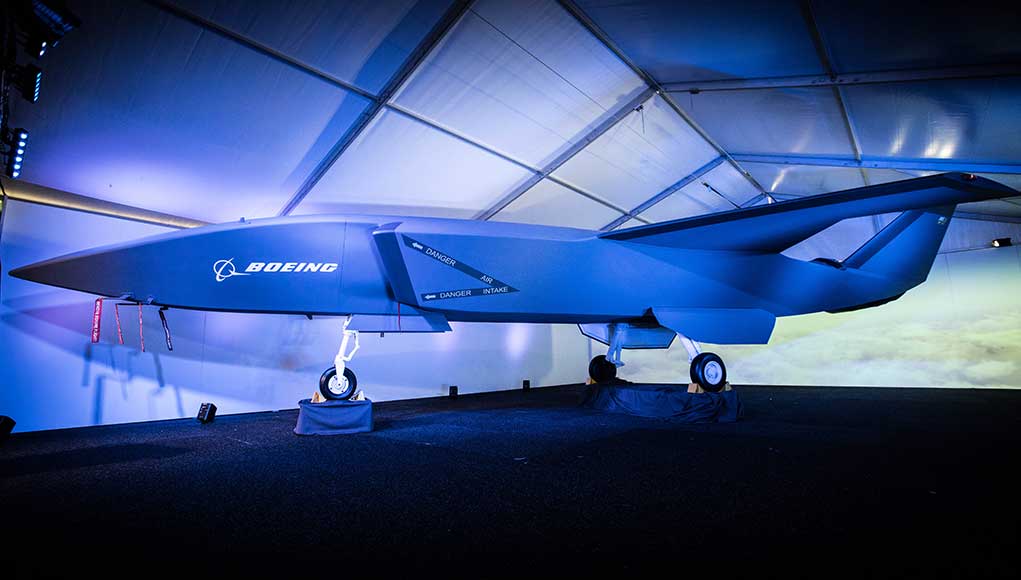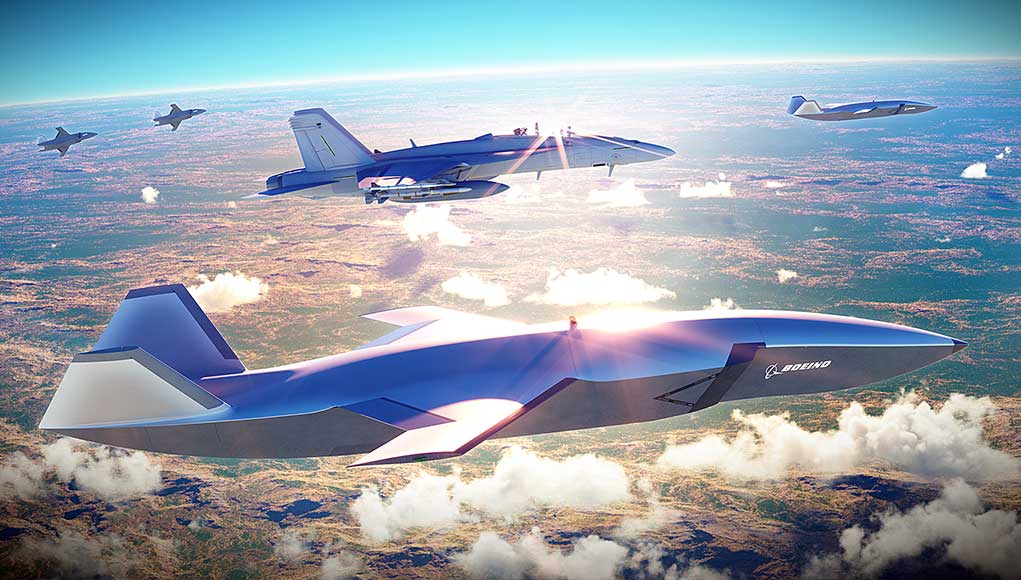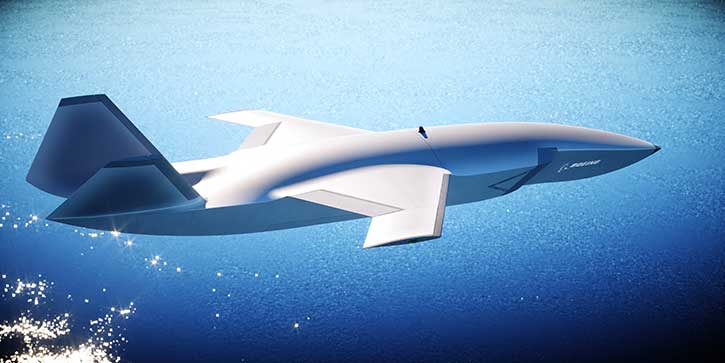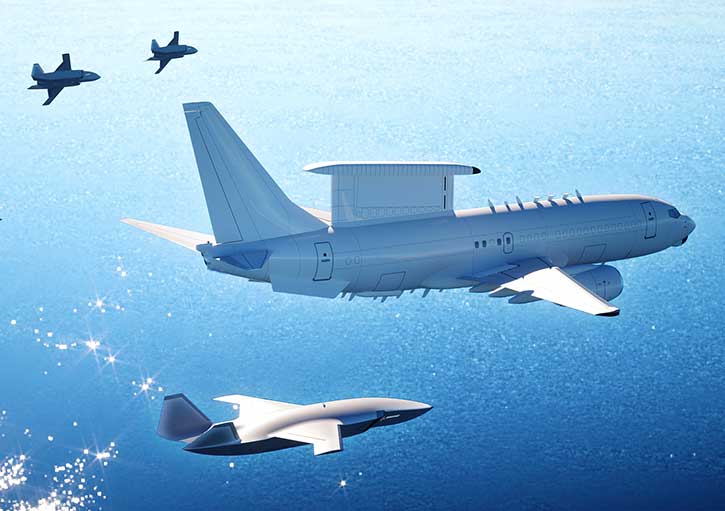
Boeing has introduced its newest unmanned platform, the Boeing Airpower Teaming System. The aircraft will complement and extend airborne missions through smart teaming with existing military aircraft. Designed and built by Boeing Australia, the project is the company’s largest investment in a new unmanned aircraft program outside the United States.
Boeing unveiled today a full-scale model of the new aircraft at the Australian International Airshow. The Australian Minister for Defence, Hon Christopher Pyne MP. that uncovered the aircraft, said the research and development activity, “The partnership will produce a concept demonstrator of a low cost unmanned ‘Loyal Wingman’ aircraft, capable of operating in concert with Air Force’s fifth-generation air combat capability,” Minister Pyne said. Boeing plans to invest over $60 million in the project, along with the Australian government that invests up to $40 million. The first flight is planned for 2020.
An operational platform based on this prototype will be able to operate alongside manned aircraft such as the RAAF F-35A, E-7, EA-18G, F/A-18E/F, and P-8 Poseidon aircraft, each evolved and came along linear development paths. Under the modernization plan called ‘Plan Jericho,’ the RAAF considers elevating itself to a ‘Fifth Generation Air Force’, enhancing today’s platforms through advanced man-unmanned teaming, to augment the human capabilities in a future combat mission. ‘Our concept of edge processing will allow us to fully develop the capabilities of each of those linear paths, to intercept and fuse into the future,’ RAAF Air Vice-Marshal Gavin Turnbull told The Strategist in an interview published today. ‘They can do highly advanced and highly effective processing on each of those platforms while communicating with each other about the information they’re gathering. And then, from the edge of that battlespace, we transmit back knowledge—not reams and reams of something that needs to be processed by lots of humans or computers.’

Plan Jericho will exploit advanced technological solutions such as manned-unmanned teaming, artificial intelligence and machine learning to make up for the RAAF relatively small conventional force.
The Air Force’s augmented intelligence approach combines the freedom and agility of the human with the power of machines creating a ‘human edge in the information age.’ Augmented intelligence is the central concept in shifting the RAAF from one that uses people to operate machines and cooperate with other people, to a force in which people and machines operate together.
According to RAAF documents Plan Jericho exploits autonomous processing to infuse machine processing power throughout the force to enhance decision-making quality and tempo, and advanced sensors to detect and track challenging targets in difficult environments. It will employ a ‘combat cloud’ to optimize decision and action tempo, by integrating the fifth-generation force and enabling resources from across the force to be distributed and applied as a unified whole. Finally, it harnesses human-machine augmentation to optimize individual and collective human and human-machine performance within a proactively developed ethical, moral, and legal framework.
‘We’re understanding that the force mix we’ll have in the future will overwhelm us with the amount of information that we can produce, and we need to get much smarter about how we deal with that.’ According to Turnbull, a future force will evolve based on requirements, but the human will always be there somewhere. ‘The air campaign in Iraq and Syria has demonstrated that human judgment is still crucial in terms of issues such as when to bomb and when not to bomb,’ Turnbull says, adding that the key is to put the humans in a place where they have the maximum effect while facing minimal risk. ‘So into the future, you have to give consideration to what the force mix looks like between manned and unmanned combat entities. And there will always be a synergy in mixing them in some way.’

The Boeing Airpower Teaming System will provide fighter-like performance in a small unmanned platform measure 11.7 m’ (38 feet) long platform, capable of flying missions beyond 2,000 nautical miles. The aircraft will have a modular design allowing ‘snap-in’ payloads and rapid reconfiguration capability. Sensor packages onboard to support intelligence, surveillance and reconnaissance missions and electronic warfare. It will use artificial intelligence to fly independently or in support of manned aircraft while maintaining a safe distance between other aircraft. The aircraft will have a level of autonomy to meet specific mission phases. Otherwise, it will be controlled via ground station, or from other aircraft.
The aircraft is developed and built in Australia where it will benefit from the vast, empty desert ranges and available airspace for experimentation. It is intended for domestic use and export, that will be easier outside the US complex foreign military sales system.
“This aircraft is a historic endeavor for Boeing. Not only is it developed outside the United States, but it is also designed so that our global customers can integrate local content to meet their country-specific requirements,” said Marc Allen, president, Boeing International. “The Boeing Airpower Teaming System will provide a disruptive advantage for allied forces’ manned/unmanned missions,” added Kristin Robertson, vice president, and general manager of Boeing Autonomous Systems. “With its ability to reconfigure quickly and perform different types of missions in tandem with other aircraft, our newest addition to Boeing’s portfolio will truly be a force multiplier as it protects and projects air power.”
According to Hon Steven Ciobo Minister for Defence Industry, Boeing will seek to team with large, medium and small Australian businesses and partner with research organizations, including universities and the Defence Science and Technology Group.




















